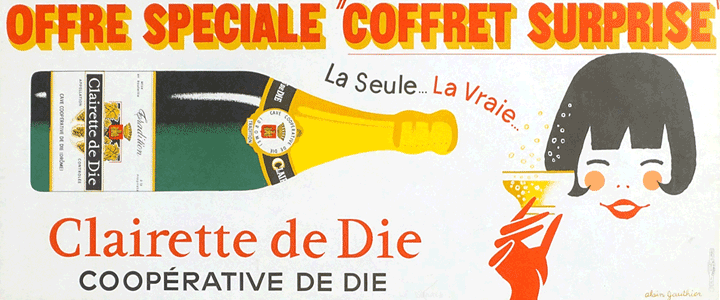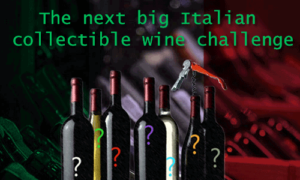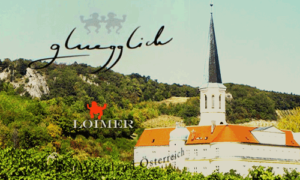A natural sparkling Muscat wine named Clairette. Confused? Don’t be.
Clairette
Clairette de Die is a naturally sparkling white wine, made of minimum of 75% Muscat Blanc à Petits Grains and generally only a tiny amount of the Clairette Blanche grape. A wine called Clairette, but mainly made of Muscat Blanc, is a bit odd when you think about it.

One of the historic wine treasures in France is a white sparkling Muscat wine named Clairette. The tale of its sparkle is nourished by an old legend of a shepherd who accidentally left a jar of wine in a river over winter to find it effervescent, or ‘pétillant’, in spring. Its offspring, Clairette de Die has Muscat grapes, but little or no Clairette grapes in it. Why it is still called Clairette? Confused? Don’t be, as the name Clairette probably derives from the phenomenon of ‘clearing’ or a clarifying* wine, and not from the Clairette grape.

Already in the year 77 AD, Pliny the Elder (23 AD–79 AD) a historian and wine lover wrote in his encyclopedic “Natural History” about a bubbly wine made by the Voconces. The Voconces used to live in the mountainous regions of southern Gaul, east of the Rhône Valley. Their sparkling wine method was quite simple and based on the above-mentioned legend. They leave jars containing wine in an icy river for a whole winter, to retrieve them again in spring. The partly fermented grapes have some residual sugar left, enough to restart fermentation after the surface temperature warms up. The result is a wine with some light bubbles.
Méthode rurale, a single fermentation in the bottle
Later called the ‘méthode rurale’, the re-fermentation is basically a continuation of the first fermentation. There is no second fermentation in the bottle. The whole process results in a slightly sparkling, partially fermented wine sweet with low alcoholic strength. This precious, sweet, bubbly wine was probably made of the aromatic Muscat Blanc. Also called white muscat, this grape of Greek origin was brought into Southern France by the Romans. Due to the high level of mono-terpenes Muscat wines have a distinctively grapey and musky aroma.
Clairette is made using two grape varieties: ‘Muscat Blanc à Petit Grains’ and ‘Clairette Blanche’
In today’s AOC rules at least 75% of ‘Muscat Blanc à Petit Grains’ needs to be present in ‘Clairette de Die’. The rest, and sometimes none at all, comes from the white Clairette or Clairette Blanche grape. Clairette has not much acidity by itself but has a certain bitterness. The bitterness compensates for the lower acidity. To retain more acidity vine growers reduce yields by pruning more rigorously and harvesting earlier. Done in the right way Clairette gives the wine freshness, outlines the wine’s backbone, and shows juicy flavors of fresh apple, peach, and green herbs.
There are three different sparkling wines permitted in the area around Die:
1. Clairette de Die – 100% Clairette, transfer method used, less than 15 g/l of sugar in the finished wine
2. Cremant de Die – traditional method sparkling, minimum 36 months ageing, mostly Clairette, some Muscat and Aligoté, second fermentation in the bottle
3. Clairette de Die Methode Dioise Ancestrale – single fermentation in the bottle, no liqueur d’expédition, the finished wine must contain at least 35 g/l of sugar.

The traditional method of making “Clairette de Die” is unique in France
The old, traditional method of making “Clairette de Die” was registered under the name of ‘méthode dioise ancestrale’ in 1971. After pressing, the grape must ferments at low temperatures using indigenous yeasts. The moment of bottling is crucial. Before fermentation is completed the half-fermented must with at least 55 g/l of residual sugar is bottled at 7-9 % alcohol to build pressure and create bubbles. The bottles are kept for a minimum of four months to age on the lees – or yeast- deposits. After at least four months the wine is racked, filtered in an isobaric way in which the pressure stays constant, and bottled under a minimum of 3 bar pressure. No sugar and/or yeast can be added legally to the wine by this method.
Much in the same way as the ‘méthode rurale’, the updated ‘méthode Dioise ancestral’ prohibits the adding of a ‘liqueur d’expédition’ – a mixture of wine and (cane) sugar to adjust the sweetness level of the wine. Regulations do not impose disgorgement or filtration to remove sediments that can cause possible cloudiness in the wine. Disgorging or filtration is used to gain more control over the end result and sweetness. The finished wine must contain at least 35 g/l of sugar. It can only be topped up, in case necessary, with wine from the same cuvée. Méthode dioise ancestrale makes up 88% of the production of Clairette de Die.

Clairette de Die is the French sparkling wine with the highest organic production area
The Muscat and Clairette vines grow on black marl and clay-limestone soils, at 400-700 meters, or higher, altitudes in the valleys of the Vercors and the Saoû mountains in the Drôme region. Where the Drôme bubbles stand out the most, however, is that around 20% of this small vineyard (circa 1,700 ha) area is organic. An almost unique proportion for all the French AOCs combined.
What makes up a good Clairette de Die?
A good Clairette de Die has fine bubbles and light effervescence, with intoxicating fruity sweetness and lightness on the palate. Marked aromas of rose, apples, peach, grapes, and citrus too. It shows how well the Muscat grape variety adapted to the stony and poor hillsides of the mountainous Die region. To enjoy its fruity character to the full, it should be drunk young, preferably within two years. Lately, we see also examples on the market with richer and more complex aroma profiles, higher acidity and a creamy, firm mousse expressing certain pureness. There is no indication of the vintage year.
Wines that give less pleasure are Clairette de Die’s with a lack of acidity, higher alcohol levels, green/vegetable flavours, overripe, reductive or not enough flavour and wines that give the sensation of being thin or diluted or not being in balance.

It feels good to reminiscence about the past
In my family, we drank quite a lot of Clairette de Die. Thanks to my father. Clairette was his favourite drink after Sunday lunch. I easily got used to aromatic, floral notes and the deliciously fresh fruity grape taste, besides the added bonus of 7-9% low alcohol content. Even now, when I open a bottle, it reminds me of those lazy summer afternoons, when we had nothing else to do but dream about La Douce France and the Drôme region. Well worth the detour for its spectacular scenery and of course its Clairette de Die wines.
*This article is inspired by the masterclass about Clairette de Die by Olivier Borneuf -wine critic & taster at Bettane
** Clearing or clarifying in the header refers to a (formerly cloudy) white wine that becomes naturally clear or ‘clairette’ when all the sediments are settled at the bottom of the barrel or bottle.


